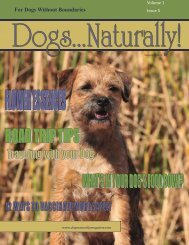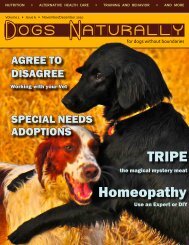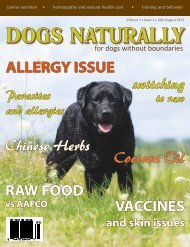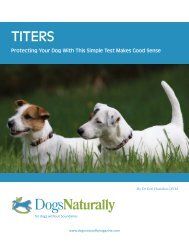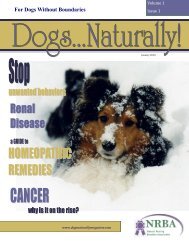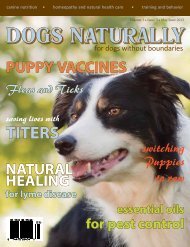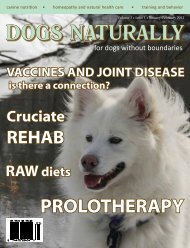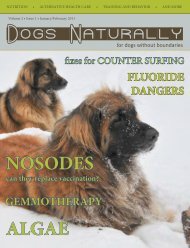July/August 2010 - Dogs Naturally Magazine
July/August 2010 - Dogs Naturally Magazine
July/August 2010 - Dogs Naturally Magazine
Create successful ePaper yourself
Turn your PDF publications into a flip-book with our unique Google optimized e-Paper software.
y: Laura Boston<br />
This article appeared in Barkleigh/Canadian Groomer<br />
<strong>Magazine</strong>. This article is copyright and may not be<br />
reproduced without permission by Laura Boston<br />
Shampoo is one of the key tools of a professional dog<br />
groomer. They expect shampoos to clean the dogs and<br />
leave them smelling nice. The key cleaning action in<br />
shampoos is done by surfactants. Surfactants, or<br />
surface active agents, can be of synthetic origin, an<br />
example being sodium lauryl sulfate; animal origin,<br />
such as tallow; or natural plant origin, like coconut oil<br />
or palm kernel oil. Shampoos may contain a blend of<br />
surfactants to create various properties such as lathering<br />
and cleansing. The molecules in the surfactants<br />
contain two chemical groups; one group is attracted to<br />
soils and the other to water. In simple terms the molecules<br />
work together to break down dirt from the surface<br />
of the hair shaft and scalp and remove it.<br />
Many of the chemical surfactants in dog shampoos are<br />
petroleum based and are known carcinogens, substances<br />
known to cause cancer. Some carcinogens<br />
may cause cancer only after prolonged high levels of<br />
exposure. If groomers don’t wear gloves these chemicals<br />
are ingested through their skin every time they<br />
shampoo a dog. A better option is to choose a shampoo<br />
that uses natural surfactants and non-toxic, natural<br />
ingredients.<br />
Different shampoo formulations can have different<br />
results on a dog’s coat. Shampoos are marketed as anti<br />
-itch, brightening, tearless, conditioning, anti-dandruff,<br />
flea and tick, medicated, hypoallergenic, and so on.<br />
Many shampoos contain harsh detergents that actually<br />
strip all of the coat’s oils leaving a fluffy looking coat.<br />
Other shampoos that claim to be “moisturizing” may<br />
contain chemical additives such as propylene glycol,<br />
which is a cosmetic form of mineral oil and works as a<br />
humescent, which creates retention of moisture. This<br />
chemical is also a skin irritant, can cause liver and<br />
kidney damage and is also found in paint, wallpaper<br />
removers and de-greasers. “Tar” which is in tar-based<br />
dandruff shampoos, is one of the first known human<br />
carcinogens. As tar is also found in all artificial colors,<br />
flavors and odors, it is best to stay away from using any<br />
shampoo containing artificial dyes or fragrances. Many<br />
perfumes that are added to shampoos are made with<br />
ethyl alcohol and synthetic chemicals. Perfumes can<br />
dry out the coat and trigger allergies in both dogs as<br />
well as humans. Some groomers even use dish detergent<br />
to wash their client’s dogs. These detergents are<br />
labeled as “mild” yet when you do a little research and<br />
read the “material safety data”, the specifics say,<br />
“Avoid skin contact as this strong skin irritant can<br />
cause dryness, is an eye irritant and if spilled on<br />
clothes, change clothes”. Many “tearless” shampoos<br />
use chemicals to counter-act and reduce irritation<br />
caused by other chemical ingredients, but these too<br />
may be carcinogenic in nature.<br />
Ultimately you simply want a shampoo that gently<br />
cleans without stripping the coat’s natural sedum but<br />
for special needs there are good, healthy alternatives.<br />
A good, basic all-purpose dog shampoo should be ph<br />
balanced for a dog’s coat, be made with natural and<br />
organic ingredients, have low lather and smell great.<br />
Look for shampoos that use essential oils. Essential oils<br />
nourish the dog’s coat leaving it clean and shiny and<br />
come in a wonderful variety of scents such as lavender,<br />
tea tree, rosehip, lemon and geranium.<br />
There are plenty of dog shampoos on the market now<br />
that offer skin treatments using natural ingredients. If<br />
a dog’s coat needs special treatment for dryness or<br />
itching, a natural shampoo containing oatmeal and<br />
aloe vera may be used; shampoos containing essential<br />
oils of rosemary, neem and tea tree help prevent<br />
dandruff; tea tree and pennyroyal shampoos are good<br />
anti-bacterial and flea repellants; lavender and calendula<br />
calm and sooth the skin. Natural oils such as<br />
jojoba, macadamia oil or safflower oil all naturally<br />
condition the dog’s coat leaving it soft and silky. These<br />
treatment shampoos are best left on the coat for up to<br />
ten minutes in order to allow the ingredients to penetrate<br />
thoroughly.<br />
Allergies have become quite common in dogs. An<br />
allergy is “ a hypersensitivity acquired through exposure<br />
to a particular substance (allergen)”. Pollen,<br />
foods, and chemicals can trigger allergic reactions in<br />
dogs. The body reacts by releasing chemicals that<br />
result in allergic symptoms such as rashes and dry,<br />
itchy skin. <strong>Dogs</strong> absorb a lot of allergens through their<br />
skin. One way to alleviate allergy symptoms is to wash<br />
the dog frequently with a hypoallergenic shampoo.<br />
These shampoos are specifically formulated with ingredients<br />
that have little likelihood of causing an allergic<br />
reaction. This does not mean that the dogs will not<br />
react to these shampoos whether or not they are<br />
made with all natural ingredients or chemical based<br />
ingredients. Ingredients that are likely to cause allergic<br />
reactions that may be listed in hypoallergenic (and<br />
other) shampoos are mineral oil, methyl paraben and<br />
propyl paraben. These ingredients can cause hypersensitivity<br />
and are linked to long-term health problems.<br />
My favourite way to apply dog shampoo is with a<br />
squeeze bottle that fits comfortably into the hand. This<br />
method is fast, easy and allows the shampoo to penetrate<br />
close to the skin. Mix your favorite professional<br />
concentrate shampoo with lukewarm water. Start at<br />
the base of head and neck and squirt the shampoo<br />
mixture into the dog’s coat. As you work your way<br />
down the back and the rest of the body, your other<br />
hand is free to massage the shampoo into the dog’s<br />
coat.<br />
When choosing your shampoo remember to read the<br />
ingredients. Familiarize yourself with ingredients that<br />
are known to cause serious health problems in humans.<br />
Choosing a shampoo with healthy, natural and<br />
organic ingredients may cost a little more but in the<br />
long run the benefits are worth it for you and the dogs!<br />
Laura Boston is President of Animal Sense Pet Products<br />
Inc., a privately owned Canadian pet product<br />
company specializing in organic pet foods and ecofriendly<br />
pet products. Heavenly Organic is a line of<br />
100% chemical free dog shampoos and spa products<br />
that that are now available for your four legged and<br />
furry-faced friends.<br />
www.animalsensepetproducts.com<br />
laura@animalsensepetproducts.com<br />
905-886-6975<br />
www.dogsnaturallymagazine.com <strong>July</strong>/<strong>August</strong> <strong>2010</strong> | 15



